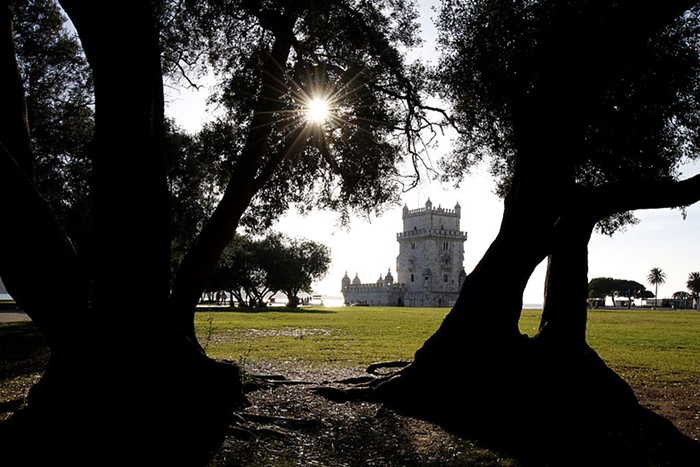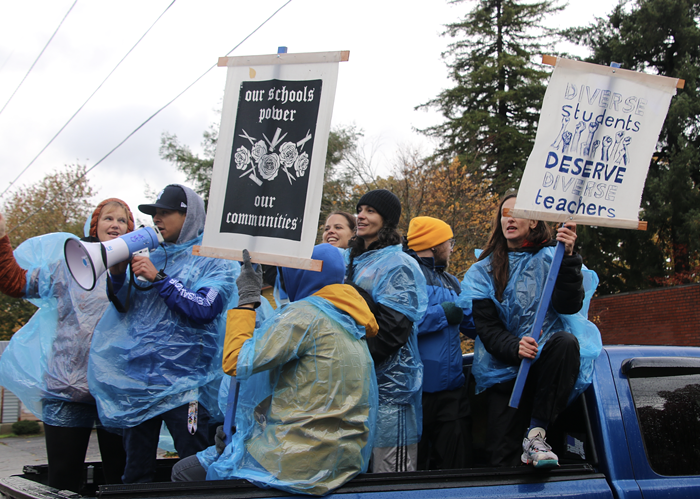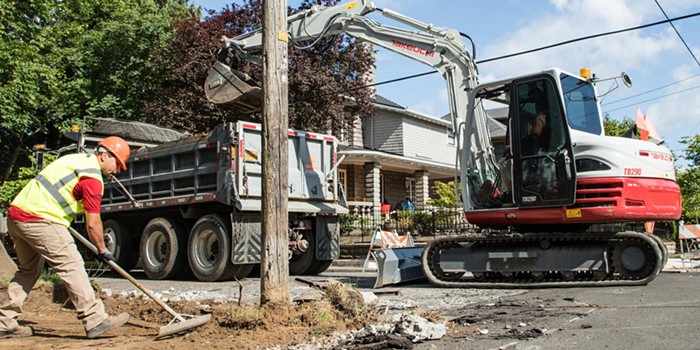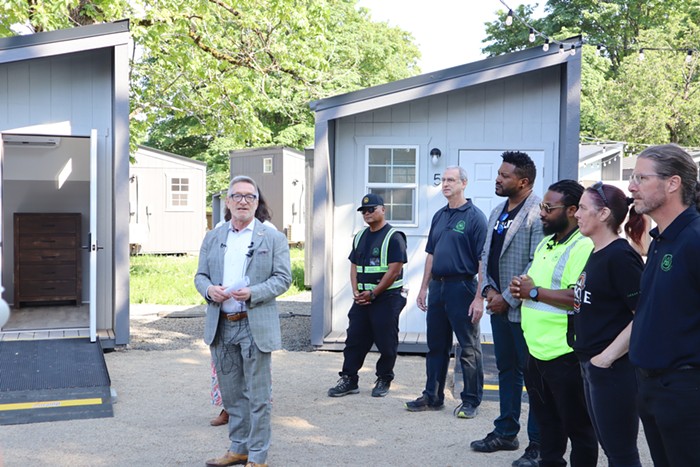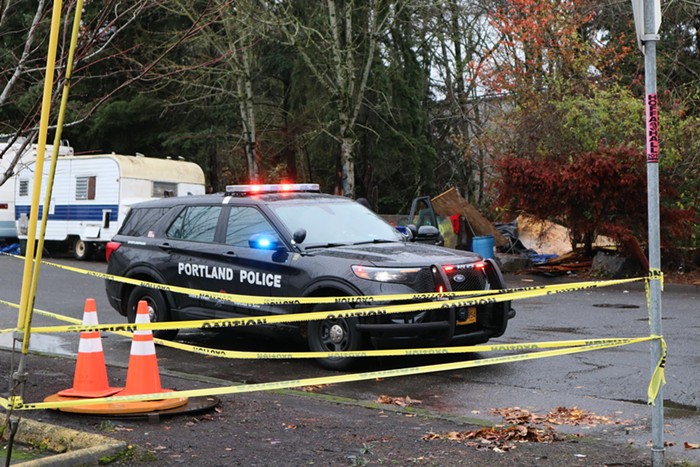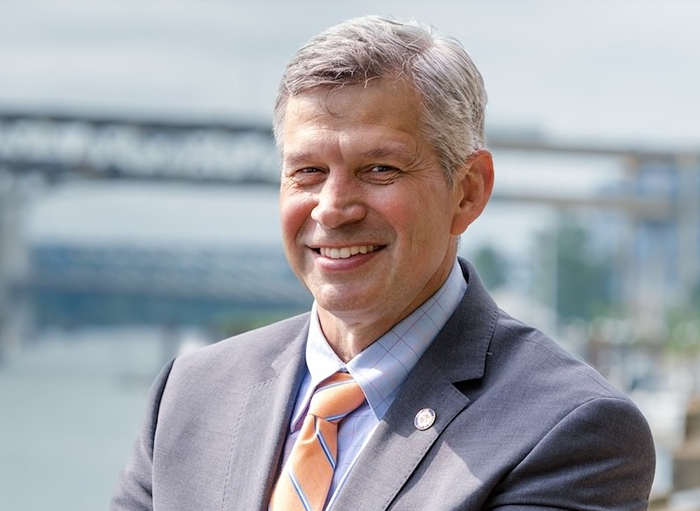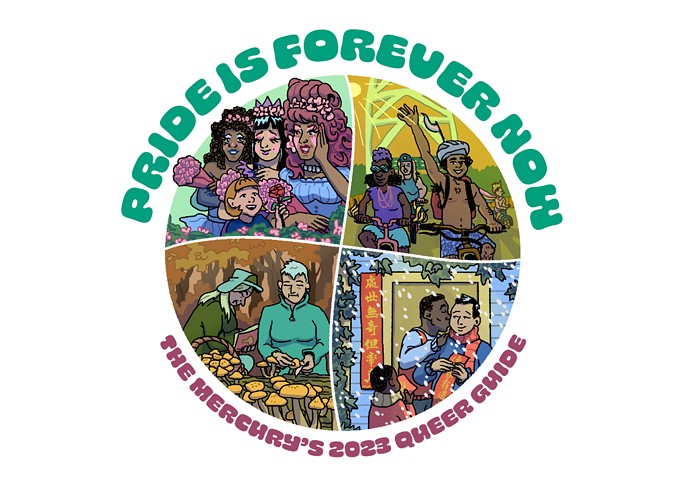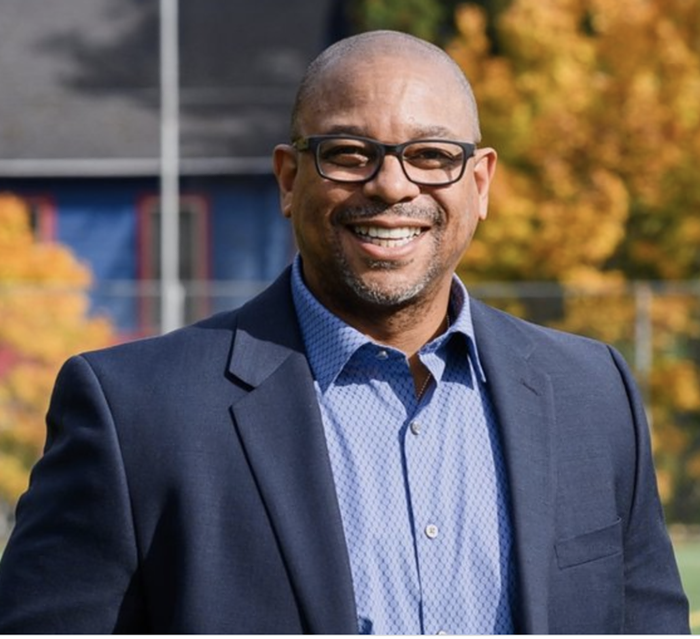
BEST BAND FROM 1988 (THAT YOU PROBABLY HAVE NEVER HEARD OF)
It's been 20 years since the Hell Cows were at their peak, but classifying this skewed art-rock band is still a challenge to this day. Vocals were neither sung nor spoken; instead they were delivered via guttural bark—similar to an ornery Captain Beefheart—while the rest of the band's free-form nature was light years ahead of their '80s rock peers. Makes sense that they released a split 7-inch with longtime noise icons Smegma, and their heavily-costumed personae became synonymous with the onstage oddities people came to expect from the Hell Cows' live experience. Says drummer Mike King, "The band was formed by visual artists and a guy who kind of knew how to play saxophone. The visual aspect was always something that was part of it, so early on we did some ridiculous and outlandish things." While their vinyl-friendly back catalog isn't readily available to those leaning on the crutch of modern digital music, 1988's Toothless is a must-have addition to any Portland music library. EAC

BEST "SURE THING" FRANCHISE THAT FAILED MISERABLY
In '88, hopes were high that Portland's own "healthy Mexican food" chain, entitled Macheezmo Mouse, might spread nationwide—bringing Portland fame and fortune in the fast food world. Unfortunately, after opening franchises in Seattle and San Francisco, the Mouse folded in the early '90s. It might be that the infamous ultra-bright, modern décor was just too much for the outside world. PAC

BEST PLACE TO PICK UP A MALE TEENAGE PROSTITUTE
There's no polite way to say it, and you won't find much in the Oregonian to back it up. But Portland's men have a rich, long-standing tradition of paying teenage boys for a fuck.
It's also damned near impossible to find anyone who'll confess to having been involved in the trade "scene" nowadays—which is why this aspect of the city's oral (cough, cough) history is perhaps in danger of vanishing faster than almost any other. But people who were around at the time recall the hustlers standing two or three deep on the corner of SW 3rd and Taylor on summer nights.
"The thing I really remember is that it was surprising how open it seemed," says John Campbell, the director of photography for Gus Van Sant's 1991 film My Own Private Idaho, which cast River Phoenix and Keanu Reeves in Portland as a pair of young hustlers selling themselves out of a fictional flophouse in the now renovated Governor Hotel on SW 10th and Alder.
"There was a certain kind of come-hither look that really made it obvious what was going on," Campbell continues. "So you'd see these guys around dusk starting to ply their trade and the nice cars, the Mercedes pulling up. It was really, really gritty."
Things have moved on. Since the establishment of youth-oriented nonprofits like New Avenues for Youth, it's almost impossible to pick up a child prostitute when you need one these days. I guess street kids just aren't putting out like they used to.
"Back then if you were gay, it was all free," says Bruce Hudson, who used to drive a cab around Portland and is now a regular at the Silverado Bar on SW 3rd Ave. "But for the straight guys who could only get away from their wives once a week or whatever, the hustlers were always around."
"They were just kids trying to make ends meet," says Virginia St. James, another Silverado regular, taking a matter-of-fact approach to what went on. "I just insisted they all try to stay safe."
Hudson remembers johns taking the hustlers to the Clyde Hotel on Stark Street—now the Ace Hotel—to seal their trysts in an $8 room. That is, if they got that far. Often things would just happen in the bars. Allegedly, the best bar to pick up—and possibly actually have sex with—a rent boy was the Portland Zoo, on SW Oak between 9th and 10th.
"The cops wouldn't even go in there, it was so crazy," Hudson says.
It's now closed. MD
BEST INAUGURAL PORTLAND MICROBREW FESTIVAL
During its 1988 debut, the Oregon Brewers Festival featured 16 beers from 13 different breweries. It had only been 10 years since Jimmy Carter signed legislation allowing a household to brew up to 200 gallons of beer annually, but Oregon's brewers were multiplying like wet gremlins. 20 years later, the OBF features 72 breweries and as many different beers—truly, one of the better things to come out of Portland in the '80s. PAC
BEST HAUNTED VENUE
In 1988, with a capacity of little less than 1,000, Starry Night was the premier downtown venue in Portland, bringing in a slew of national acts while nursing the rise of local pop acts like Nu Shooz and Crazy 8s. But the space, which is currently the Roseland Theater, has a very bloody history. Starry Night's owner, Larry "Scary Larry" Hurwitz, was involved in the murder of an employee inside the venue itself. Following a botched counterfeit ticket scam during a Monqui Presents John Lee Hooker concert in 1990, Starry Night employee Timothy Donald Moreau disappeared. Turns out that Moreau was strangled in the hallway of the club by stagehand George Castagnola and Hurwitz. The Starry Night was sold in 1991, but the body of Moreau, rumored to be buried on the Washington side of the Columbia Gorge, has never been found. EAC
BEST REASON TO GO TO A MALL
In 1988 people were so into MTV, they flocked to malls to be a part of the culture sensation. In fact, the Clackamas Town Center was on the list of a "30 week tour" of a make-your-own-rock-video booth, complete with hair spray and an on-site movie producer to insure you projected the perfect "hair rock" look. Plus, you got to keep the video of yourself acting like a fool! A rendition of Rick Astley's "Never Gonna Give You Up," anyone? CN

BEST USE OF PORTLAND LANDMARKS IN A DECENT, UNDERLOOKED FILM
1988 saw the groundwork laid for the Portland-shot production of Breaking In, a film directed by Bill Forsyth (Local Hero) and written by indie auteur and script-doctor-for-hire John Sayles. Although the film wasn't exactly a box-office sensation, it was prestigious enough to close the New York Film Festival in 1989. It's a buddy comedy of sorts, starring Burt Reynolds—in his first glammed-down role, complete with limp and gray hair—as an aging thief who takes on a very stupid, goofy sidekick named Mike, played by Casey Siemaszko, who you probably don't remember from Back to the Future and Young Guns. The two crack open safes in some notable Portland locations, including the Alano House (909 NW 24th), a stately mansion that in real life functions as a recovery support center, and the late, lamented Corno's Food Market (711 SE MLK), distinguished by the comically oversized fruit depicted in the store's sign. Meanwhile, Mike works at a tire store at "12th and Division, Southeast," while Reynolds lives improbably close to PDX, and the dynamic duo takes a pair of remarkably unskanky hookers out to an unidentified chintzy restaurant. But Breaking In's most memorable location is the climactic setting of their big score: Oaks Park Amusement Park. We see roller skaters and carnival games and Fourth of July fireworks, and while a fresh look at the film reveals that Portland has dramatically changed over the past 20 years—and, judging by the tired, run-down look of most of the movie, it's changed for the better—it's warmly comforting to know there's still a bastion of old-time America in town, as iconic and timeless as it was in '88, when filmmakers used it as a symbol of innocence that never fully evaporates, no matter how many safes are cracked and scores are made. NL
BEST RESTAURANT NAME THAT SOUNDS LIKE A SEXUAL EUPHEMISM
In 1988, The Rusty Pelican was located on the waterfront and known for its wide array of fresh seafood. An advertisement from the period touted the Rusty Pelican's "wildlife," which meant dancing, drinking—and if you played your cards right—perhaps the chance for a Dirty Sanchez or a Cleveland Steamer later in the evening. PAC

BEST WEDDING ON PUBLIC TRANSIT
It was a cold December day, back when the MAX was young and its rails not yet burdened with age and the line to Beaverton. Its riders, too, were giddy with youth and drunk on champagne.
"Howard and I didn't have a lot to spend on a wedding or reception, so we wanted to keep it simple," remembers Kathleen Mehann. Also, she adds, "We're both crazy." The couple decided to be the first people ever married on a MAX train, so for a couple hundred dollars, the two rented one of their own.
The groom's party met the pride of Portland transit in Gresham, clambering into the train for what would be, for some, a first foray onto the two-year-old MAX. The crowd was so large it became difficult to walk between the cars, but the groom, Mr. Howard Meehan, stood out in his black tuxedo. A sign reading "Private Party" hung on the side of the train as it swooped down the Eastside rails.
At the majestic Lloyd Center, the bride swept through the train's glistening steel doors in a hand-sewn white satin gown. She carried a bouquet of white lilies. Over the loudspeakers, a woman began singing the couple's tender wedding song, Bridge Over Troubled Water.
Kathleen laughs about the song choice now, from her home in New Mexico. "We wanted a song about a bridge," she says, "If only we'd known the troubled water would be our own!" Now in their 60s and both professional artists, the couple split after 16 years together. Portland, though, remains wedded to its train. SM
BEST CRACK HOUSE IN PORTLAND
In 1988, it was crack that supported the hierarchies of Portland's violently dueling Bloods and Crips, and police estimated a whopping 75 to 100 crack houses existed in the Rose City. The biggest drug neighborhood was "Crack Alley"—the streets running east of NE Union Avenue (now MLK). "The houses had no shades; they'd throw bedclothes over the windows," recalls Dick Bogle, a city commissioner in 1988 who worked to end gang violence. "Street drug activity was bold and rampant." Bogle remembers a "corner boy" once offered to sell him crack as he drove through the neighborhood, his car packed with city staff.
From this cavalcade of crack covens, though, one rose from the ranks: a house situated on the corner of NE Roselawn and Union. The house was the centerpiece of an Oregonian profile that found the living room dealer sold crack to 20 people in one afternoon, averaging four sales per hour. The crack was affordable, too, at only $10 a rock. It's not just strong sales that made the Roselawn home Portland's number one crack house for 1988, though. The dealer's attention to cleanliness and cop-avoidance also received high ratings. "Police found that almost everyone there had a well-defined role," raved the Oregonian profile. The dealer paid a man $25 a day to clean up crack pipes and matches on the property. A porch bouncer netted $30 a day to let customers in and keep an eye out for police.
These days, Crack Alley is the site of a row of fresh-looking townhomes and green lawns. Despite repeated and desperate inquiries, I was unable to find anyone that would sell me crack. SM
BEST WAY TO ENJOY BORING MUSIC
According to the music section in a 1988 edition of Willamette Week, the best way to enjoy the work of Edvard Grieg, a Norwegian classical folk musician from the turn of the century, was on a set of 10 compact discs. Even then the WW had their finger on the pulse. SB
BEST USE OF SEVEN GRAND
In 1988, you could buy a LaserWriterII, one of the first laser printers for Apple computers, at Beaverton Town Square for about $7,000. That is only twice as much as a personal home computer would've cost at time, and only 70 times more expensive than my current printer. SB
BEST PLACE TO LEARN ABOUT MAGICAL SPECTACLES AND MYSTICAL UNDERWEAR
As someone who grew up in Utah and has a fair amount of ancestral Mormon blood coursing though my veins, I think I'm probably in the clear to say this: Mormonism is crazy, whether you're talking about the magical spectacles that supposedly allowed Joseph Smith to translate The Book of Mormon or the bizarre one-sies that Mormons wear underneath their clothes. (Okay, technically, they're called "garments," and technically, I may or may not have been involved in an incident at Boy Scout camp where we ran our scoutmaster's "garments" up a flagpole. Also, technically, I may or may not be doomed to Hell for all eternity.) But no one was more aware of the Mormons' weirdness than the terrified residents of Oregon, who fought against the Church of Latter Day Saints' 42nd temple when it was built in Lake Oswego from 1986-1989.
Several Lake Oswego residents tried to keep the temple from being built. "The church leadership is trying to impose something that doesn't fit in here," 20-year resident Wilma McNulty told Oregon Magazine, citing everything from "light pollution" to land use as reasons why the Mormons shouldn't be allowed to build their temple in Lake Oswego. ("I think there's no question religious prejudice plays a role," said James Bean, a Mormon attorney who represented the church.) The Mormons eventually won out, building their first-ever Oregon temple in Lake Oswego. 20 years later, as the marble-clad temple serenely towers up to the heavens, with its gold-plated statue of Moroni presiding over all of us, I think we can all feel just a little bit more righteous. Or guilty. Or both. Mostly, I just feel like it'd be funny to run some more magical underwear up a flagpole. EH
BEST RIDICULOUSLY CHEERFUL POP MUSIC THAT SEEMS ENTIRELY AT ODDS WITH SINGER'S UNTIMELY DEATH
Never Ever was one of the more prominent mainstream bands on the Portland scene in the 1980s, but in July of '88, lead vocalist Mat Madison was killed in a Seattle bicycle accident. The band has been pretty much forgotten entirely; their brand of dance-ready, shiny-eyed melodramatic pop did not survive the decade, and is a little too sunny and upbeat to be sought after by today's irony-loving retro-lovers. (The band's garageband.com page says one of their chief influences was middle-of-the-road Aussie gloss-pop band Icehouse, for chrissake.) Still, a song like "Wondering" is so guilelessly pleasant and eager to please, and "Don't Cry for Me" is so absolutely poised in its unabashedly cheesy '80s glory, that Never Ever could be overdue for a revival. NL
BEST LIBERATION FROM A CONFINING BACK BRACE
Doctors at the Shriners Hospital for Crippled Children freed four-and-a-half-year-old Gresham resident Brandon Persyn, who suffered from spinal muscular atrophy, from his confining back brace in the fall of 1988. The removal of the brace alleviated Brandon's mother Eunice from the task of having to carry him around everywhere, as well as Brandon's heavy sweating problem. SB
BEST SUGGESTION BY WILLAMETTE WEEK
Willamette Week wasn't always the edgy periodical we know and love today. Back in the '80s, when they weren't hyping up acid jazz or classical music, they were suggesting their readers attend a December 8th performance by comedian Jay Leno. (Maybe he was funny back then?) SB

BEST DOWNTOWN DESTINATION
The Northwest's first shopping mall to take up an entire city block is right in front of your nose—but you probably don't even know it's there. The Galleria at 921 SW Morrison was once the hub of downtown Portland's energy, where people went to shop, eat, or just to hang out. If you were a teenager in Portland during the late '80s, you almost certainly logged long hours drinking coffee at Coffee Ritz, which was rumored to house Portland's first espresso machine. Even onetime resident Courtney Love is said to have haunted the place in her early delinquent days.
Bustling with legendary stores like Josephine's Dry Goods, a fine fabric store that continues to operate in a separate location at 521 SW 11th, the last chapter of the 20th Century saw the Galleria begin to descend into obscurity. A historic landmark built in 1909, it had a 100 percent occupancy after its then-new owners held a grand reopening in 1976. It has since changed hands between different wings of the Naito family, and observers speculate that the mall declined due to Naito family feuding, as the retail heart of the city meanwhile wandered farther eastward (think Pioneer Place). The one thing everyone can agree on is that the building had become a dead zone by the close of the '90s.
These days things are looking up again for the Galleria, which is now home to the Western Culinary Institute and new retailers like Brooks Brothers. (Ironically, the city seems to be welcoming the preppy new tenant of the nationally registered historic landmark by evicting another bit of local history across the street: Peterson's Market.) Even better, the west end of downtown has seen a revitalization in the wake of the Ace Hotel opening, with new shops, bars, and restaurants encouraging foot traffic in the area. Downtown Portland is a lot bigger and busier than it was during the Galleria's heyday, but it now has a chance to ride this new wave. MS
BEST TV-INSPIRED INFERIORITY COMPLEX
Thousands of Portland-area children must have passed through the studios of the locally produced Ramblin' Rod Show, on which button-bedecked host Ramblin' Rod Anders showed cartoons in front a live studio audience. This means that thousands of adults must currently suffer from something I like to call the "Smile Complex." See, on each episode, in between Looney Tunes, Ramblin' Rod asked the kids in the audience to participate in a Smile Contest. The winner received a free Pop Shoppe Soda. The losers? They quickly learned that their smiles just weren't good enough... and never would be. Thanks a lot, Ramblin' Rod. AH
BEST CAROUSEL MUSEUM
Back when downtown's World Trade Center was the Willamette Center, it housed the Portland Carousel Museum. Strangely enough, an economy like Portland's couldn't support such a venue. It has since been renamed the International Museum of Carousel Art and was moved to Hood River. SB
BEST PRE-HIPSTER RESTAURANT
Hamburger Mary's occupied a spot downtown where Fox Tower now stands. A kind of gay burger franchise, Hamburger Mary's was not necessarily famed for its food. Still, it was loved by the out downtown community—a bit dirty, with lots of "South Pacific kitsch," offering patrons a view of yet-untamed downtown. Hamburger Mary's was one in a string of businesses at the end of the South Park Blocks to cater to Portland hipsters—that is, before Portland actually became hip. PAC
BEST USE OF THE FIRST AMENDMENT
The state of Oregon realized that outlawing phone pornography, also known as "phone sex," and "dial porn," is a violation of the First Amendment. It is unclear whether officials wanted to clean up the telephone lines or reduce the number of exorbitant phone bills racked up by children calling 1-900 numbers while their parents were at work. SB

BEST LOCAL BUSINESS (THAT IS, IF YOU WANT YOUR CUSTOMERS TO KILL THEMSELVES)
In 1988, the most annoying and baffling business ever conceived was in the downtown Galleria, and it was called... wait for it... YOU'RE THE BEARRIES. Rather than try to explain this unfathomable store, check out this description from the First Portland Catalogue (Third Edition): "If you love bears, you cannot bear to miss You're the Bearries. This business is the lair for Portland 'bearophanalia.' Your custom designed bear can be patterned after Oregon wild fruit—the Oregon Bearries, including Hucklebearry, Olallie Bearry and..." BLAM!! (That sound would be me blowing my head off.) WSH
BEST PLACE TO GET UNRELIABLE MOVIE REVIEWS
Die Hard has been called a lot of things—some words that spring to mind are "awesome," "amazing," and "fucking great"—but "too slow" hasn't ever been one of them. Well, except for Ted Mahar, the movie critic for the Oregonian in 1988, who was utterly bored throughout the "monotonous" and "derivative" Die Hard. (To add insult to injury, right above his two-star review for Die Hard, he gave a glowing, three-and-a-half star review to the Charles Grodin/Robert De Niro flick Midnight Run, "a comedy with a lot of heart.")
Provided you didn't want to see Chuck Grodin heartfully clown around or suffer though the pedestrian day-to-day life of John McClane, there were plenty of other great movies released in '88: The 10 top grossing films of the year were Rain Man, Who Framed Roger Rabbit?, Coming to America, Big, Twins, Crocodile Dundee II, Cocktail, The Naked Gun, Oliver & Company and Beetlejuice. Crocodile Dundee II and Oliver & Company aside, that's not a bad list: Eddie Murphy was still funny, Tim Burton was in his prime, good ol' O.J. was hamming it up slapstick-style, and Tom Cruise was still a charming heartthrob and not a raving cultist.
Some other great stuff from '88: A Fish Called Wanda, Big, Scrooged, Willow, Akira, Mississippi Burning, Big Top Pee-wee, Back to the Future Part II, Alien Nation, and Tin Toy, one of the first short films from some bullshit company called Pixar. Admittedly, I didn't see any of those, because at the age of eight, I was already delving into the burgeoning VHS scene, checking out such direct-to-video classics as Big Bust Babes 4 and Afro Erotica (Numbers 21-29). Obviously, it was a pretty good year for movies. EH

BEST PLACE TO FIND TOM PETERSON HALLOWEEN MASKS
For those of us who weren't living in Portland in 1988, we missed out on possibly the coolest promotional swag ever—the Tom Peterson Halloween mask. Then, as now, Tom Peterson was one of the most well known faces in the Northwest. As owner of Tom Peterson's and Gloria's Too (8130 SE Foster), Tom was a master of self-promotion, plastering his face on TV commercials, billboards, trucks, and a wide array of awesome promotional items including T-shirts, posters, coffee mugs, balloons, coloring books, specially minted coins, and yes... HALLOWEEN MASKS. And for those so inclined, he also offered free flattop haircuts (just like Tom wore) at his appliance and furniture store every Sunday. A narcissist? Maybe. But I'd love to be him, too. WSH
BEST DRUG TO OVERDOSE ON
Cocaine—in its new and improved '80s version, crack—beat out black tar heroin as the drug most responsible for overdose-related deaths in Oregon in 1988. Not only does crack wreck your cardiovascular and central nervous systems, it also causes its users to act like complete fools. For example, in February of 1988, Leon P. Hoffard Jr., an accountant for the Office of Fiscal Administration, smoked too much crack, started vacuuming his office, took off all his clothes, ran naked through two buildings, and attacked a newsstand clerk, all before suffering cardiac arrest and dying. SB
BEST VANDALISM AT AN ALTERNATIVE SCHOOL
The students at the Waldorf School in North Portland had been "weaving a peaceful world" on a seven-foot-high metal sphere intended as an entry in the Junior Rose Festival Parade when they fell victim to thoughtless vandalism. The perpetrators jumped on, crushed, and bent the peace globe before breaking into classrooms to smash up a cello and plaster the walls in graffiti. This wasn't the first time the Waldorf School was vandalized. Earlier in the year, someone set a wooden playhouse, which had been built by the third grade class, aflame. SB
BEST IRONIC REINCARNATION OF THE BUDDHA
In the '80s, the Bhagwan Shree Rajneesh made himself famous in Oregon by starting a cult, causing a salmonella outbreak in the Dalles, and trying to murder a bunch of people. In 1988, he changed his name to Rajneesh Gautama the Buddha because a Zen prophetess declared him a reincarnation of the roly-poly teacher. Though the religion teaches that worldly possessions produce misery, Rajneesh Gautama the Buddha owned at least 93 Rolls-Royces. SB

BEST PURCHASE MADE BY PAUL ALLEN
Paul Allen, who co-founded Microsoft and therefore, has more money than God, purchased the Portland Trail Blazers. While the team barely made the playoffs that year, 1988 signaled the beginning of the end of the Sam Bowie era and the start of the Rick Adelman years, where the mustachioed coach assembled a mighty squad which would soon return the Rip City glory to town. EAC

BEST STRIPPER OF 1988
You may have heard of Mary's Club (129 SW Broadway), the legendary downtown strip club that boasts the distinction of being Portland's first topless bar (these days it's all-nude). But back in '88, there was another club owned by Mary's Roy Keller called the Carriage Room, at 1000 SW Broadway. There, the girls were more cabaret performers than strippers, taking the stage to perform (to a soundtrack on cassette tapes) in dramatic evening gowns, with less emphasis on getting undressed. When the club's lease ran out 20 years ago, the building was torn down and the club vanished. One of the young women who danced there was Nikki, who began dancing at age 18 in 1986, and has had an almost continuous career at Mary's ever since. (She took a brief break to work as a body double for Lara Flynn Boyle in The Temp, and was also involved in the Andrew Dice Clay flick Brain Smasher... A Love Story, filmed in Portland.) Now almost 40, she's still in the same shape she was 20 years ago, and her early experiences as an entertainer at the Carriage Room are evident in what was described in the very first issue of X Magazine (which you now know as Exotic) as "incredible athleticism balanced with graceful ballet influences." She herself considers what she does more dancing than stripping, and her attitude is as enviable as her figure: "If you're almost 40 and you're still hot, why lie about your age? Own it!" MS
BEST PIONEER OF THE NEEDLE-EXCHANGE PROGRAM
In June 1988, the New York Times reported exciting news: "The nation's first authorized distribution of free hypodermic needles to drug addicts in hopes of preventing the spread of AIDS will begin next month in Portland, Ore., sponsors of the program announced."
Why Portland? "Oregon has no laws requiring a physician's prescription to buy or possess a needle and syringe, and no laws prohibiting needles as illicit drug paraphernalia," the paper reported.
Outside In spearheaded the program, which was slated to help 125 addicts at the outset. Unfortunately, President Bush (the first one!) got involved. He made it clear he opposed needle exchange programs, which made it difficult for Outside In to get liability insurance: "The insurer explained that it had decided to withdraw coverage because the company did not want to go against the wishes of the president of the United States," according to a 1993 report from the Needle Exchange Program Evaluation Project. Outside In found a new insurer, got assistance from Multnomah County, and scored a grant from the American Foundation for AIDS Research; the exchange was launched in 1989. AJR
BEST REASON FOR CITY COUNCIL NOT TO COME IN TO WORK
There were lots of city initiatives on the 1988 ballot—scintillating things like "Revising Charter Listing of Successors to Council Seats in Emergency," and "Deleting Certain Purchasing Procedures."
But one initiative rose above the rest—and voters promptly smacked it down. The question to voters: "Shall Charter be amended to allow Council members to participate in meetings by telephone if public able to listen?" In other words, allowing the Council to literally "phone it in."
More than 51,000 voters were cool with the idea, but a technologically averse majority of 69,868 voters said hell no. Every other city measure on the ballot passed. AJR
BEST WAY TO CURB TRIMET VIOLENCE
In November 1988, seven state troopers started riding TriMet buses and MAX trains under orders from then-Governor Neil Goldschmidt. The goal? "To curb a wave of violence battering [the] mass transit system," wrote the Washington Post, after Goldschmidt's plan scored national attention.
In the months prior, rowdy passengers assaulted drivers and other passengers, according to the Oregonian, with problems focused on the 7, 8, and 75 bus lines. "Once we had verbal assaults," Tri-Met General Manager James Cowen told the paper. "Now we're talking knives and guns." (Blame the Crips and Bloods.)
Local police departments—including Portland's—had their own staffing issues and couldn't spare officers for the transit system. The novel state-based approach to public safety cost $31,000 a month, until Portland cops took over the job the following spring. AJR
